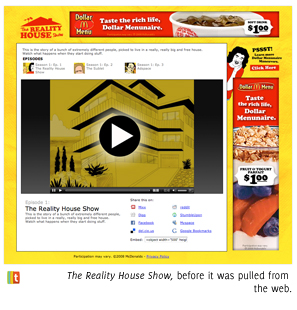Big brands have to make bold moves to defend their position in the market and McDonald’s, one of the biggest brands in the world, is no exception. In September the world’s largest fast food chain launched its first ever web series, The Reality House Show, an animated series following the goings-on at a fictional Real World-style beach house, populated by a tawdry cast of tried but true reality genre caricatures. But now the show, which has racked up less than 1,400 views on YouTube at the time of publication, has all but disappeared from the net.
Back in 2007, McDonald’s and its interactive agency of record Tribal DDB Worldwide wanted to launch a new campaign focused on attracting the coveted 18-34 year old demographic to eat on the cheap from its Dollar Menu. So they created Paul, the Dollar Menunaire. Reminiscent of a character you would find on Cartoon Network’s late night Adult Swim, Paul lived in his parents’ basement, and sustained himself exclusively on, you guessed it, McDonald’s Dollar Menu items.

Subscribe for daily Tubefilter Top Stories

Fast forward to summer 2008. Tribal DDB and McDonald’s decide to take Paul out on his own—but they don’t want to see him starve, so they toss him into a reality show with fellow inhabitants Mike, Paul, Chloe, and Tiffany, and generously feed them all, you guessed it, Chicken Sandwiches, McFries, and cheeseburgers. They wanted Paul to have a good time, so they made some major commercial buys on sites like Hulu, EPSN and IGN, hyping Paul’s and the show’s impending September 8 launch, and ensuring that he wouldn’t be living out his Big Brother fantasy all alone.
 Then, just as fast, the show was gone. Two of the three episodes remain on MickeyD’s YouTube Channel, but the site WatchRealityHouse.com now redirects to a static Dollar Menu advertisement on McDonalds.com. Oddly enough, as of today, the ads on Hulu (watch one below) are still running strong—sometimes two or three per show, all tail-slated with the show’s now defunct URL, which is still accessible, but only if you know the precise address of the page you are trying to access.
Then, just as fast, the show was gone. Two of the three episodes remain on MickeyD’s YouTube Channel, but the site WatchRealityHouse.com now redirects to a static Dollar Menu advertisement on McDonalds.com. Oddly enough, as of today, the ads on Hulu (watch one below) are still running strong—sometimes two or three per show, all tail-slated with the show’s now defunct URL, which is still accessible, but only if you know the precise address of the page you are trying to access.
So, what happened to the show? Was McDonald’s displeased with the fact the site only pulled in four-thousand visitors in all of September and October? Was it the dismal reception on YouTube? Probably. But the real question is why audiences didn’t resonate with a character that, in other mediums, had been the public face of McDonald’s wildly successful Menuaire campaign for nearly two years. Most likely because the show didn’t make sense and plugged McDonald’s products five or six times per two and a half minute episode.
The Reality House Show is a prime example of why big brands need to source ideas from web television creators, not agencies. The world of web television isn’t anything like the world of television commercials, and it shouldn’t be treated as such. You’d never build a television show around a product, and you shouldn’t do that with a web television show either. Product integration, a la Vitamin Water in Ashton Kutcher’s BlahGirls or Adobe in Agency of Record is great, but you have to divorce the content from the advertisement, or integrate it in a way that actually makes sense. So, listen up brands—if you’re planning to finance your own shows, hire someone else (not your agency!) to create it for you. Not only will you save loads of money, but in a landscape full of sophisticated audiences who can sniff out a commercial shill in two seconds flat, I guarantee that you’ll actually find a tribe of viewers who care—and if you’re smart, you’ll know that that’s exactly what you should be looking for.








